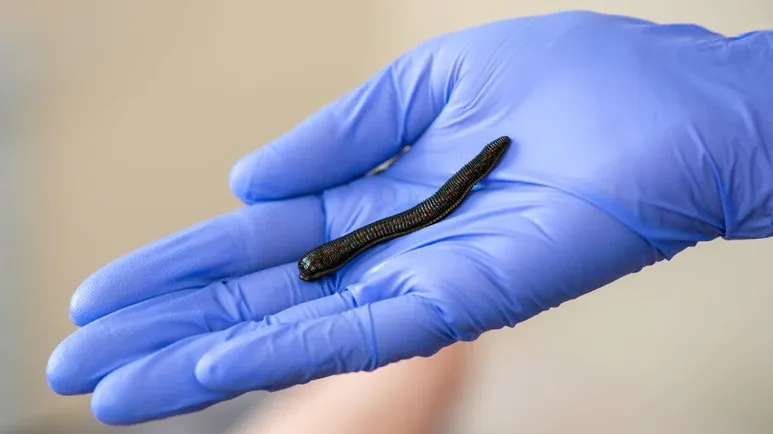You'd Probably Call This Treatment Gross, Yet It's Safe and Incredibly Effective
It used to be common even in human medicine, then it was dumped for more 'modern' therapies. But it's back and proven more effective than its imitators for vascular problems, wound care, arthritis, and inflammation. Have this discussion with your holistic veterinarian about it.

STORY AT-A-GLANCE
- Medicinal leeching is re-emerging in both human and veterinary medicine as a highly effective natural treatment for certain conditions
- Leeching is a minimally invasive therapy, and there’s little to no pain involved. It is considered safe, side effects are rare, and animals generally tolerate the therapy very well
- Leeching can be the perfect treatment for many blood and vascular related disorders, especially for patients for whom anesthesia is risky, or for whom there is no effective traditional treatment
- In veterinary medicine, leeching has been successfully used to treat arthritis, wounds, and blood, vascular and inflammatory conditions (including blood clots and stomatitis)
- Leech therapy has also shown an astounding 92% to 94% improvement rate when used to treat equine laminitis
Editor's Note: This article is a reprint. It was originally published March 13, 2016.
Although the idea seems rather ghoulish and gross, the use of leeches in modern day medicine actually has a lot of science to back it up. In fact, the Food and Drug Administration (FDA) approved leeches as "medical devices" over 10 years ago.
Throughout the 18th and 19th centuries, medicinal leeching was used to treat a number of human conditions, including mental disturbances, whooping cough, gout, tumors, headaches, and obesity.
However, not many people back in those days documented the effectiveness of leeching, so the practice dropped off in the 20th century.
Leeching has re-emerged in human medicine in Germany as well as the U.S. as a highly effective natural treatment. The practice is also growing substantially in veterinary medicine, thanks primarily to holistic and integrative veterinarians.
An Expert Explains Medicinal Leech Therapy
Dr. Ben-Yakir has been very helpful in providing additional information and has graciously provided all the photos and video clips included here. Here are two questions asked for the purposes of this article:
Q: How did you begin using leeches in clinical practice?
A: "In 2001 we summed up (at Wingate Academic College, Israel) our clinical success rate in treating different animal maladies. We found out that in some animal conditions we are doing pretty badly, and upon searching more deeply into these specific diseases we found out the similar situation globally.
Another point that was found in this research of ours — all these diseases are blood borne conditions.
The next question that we asked ourselves: 'Is there a therapeutic tool that we did not think of that might improve our prognosis in these blood related conditions?' and medical leeches came up, an old tool used by the medical and veterinary professions for centuries. That was the beginning of the long walk."
Q: What applications do you use leeches for?
A: "When we are presented with any clinical case we are asking ourselves 'Is this case a blood related condition?' and if so we begin using medical leeches. 'A horse with equine laminitis — is it a blood related condition? Yes it is.'
All the blood vessels at hooves area are stagnated, so we apply the leeches and from clinical successes rate of coming back to normal work of 65% we were and still are up to 94%.
'Feline (cat) thromboembolism (saddle thrombus) is it a blood related disease? You can bet it is.' So we apply medical leeches and success rate of coming back to normal life went up from 55% to about 90%.
'Animals that are candidates for leg amputation due to a severe gangrene — it is blood related condition?' Yes, that is the source of the problem — so we treat it and again no more legs amputations."
Leeches 101
There are over 700 known species of leeches, but the one that's more commonly used for medical purposes is Hirudo medicinalis, which can grow to around 8 inches long and is a brownish-greenish color with red stripes running the length of its body.
Medicinal leeches are an ancient species having been around for millions of years. From "The Use of Leeches in Veterinary Medicine" by Michael Aurich and Anke Henne:
"Due to their medicinal efficiency, they have established a kind of symbiosis with their hosts when suffering from certain frequent mammalian diseases. According to several reports, sick hoofed animals go intuitively into leech waters in search of 'therapy.'"1
Medicinal leeches naturally attach to (bite) their hosts in areas of the body that have a good blood supply or are inflamed. Since the leeches can often locate those areas without help, instead of placing them on the treatment area, some experienced veterinarians allow the leeches to find the location themselves.
Leeches have large suckers on one end of their bodies that help them crawl and attach to things. They also have a smaller sucker used for feeding, and a tri-part jaw that leaves a star or a Y-shaped mark.
Leeches are sanguivorous, which means they feed on blood, and they can store blood inside their bodies for months. They're also equipped with gut bacteria that helps break down the components of blood.
How Leeching Works
There are at least 100 bioactive substances identified in the saliva of leeches, the most common of which is hirudin, which gives the saliva its anticoagulant properties.
Leeching is minimally invasive, and there's little to no pain involved thanks to an anesthetic substance found in leech saliva. When a leech feeds, it can remove 1 to 2 teaspoons of blood per feeding. The site will continue to ooze an additional 1 to 2 teaspoons for another 24 to 48 hours after the leech falls off or is removed.
As soon as a leech attaches to the treatment area, it begins to release saliva into the wound, which causes the host animal's blood to become very dilute and fluid, with inhibited coagulation. Shortly afterwards, the leech starts feeding on the host animal's blood. It sucks mainly venous blood, which resolves congestion.
Meanwhile, the leech's saliva continues to be released into the wound, providing anticoagulant, anti-inflammatory, and antibiotic benefits to the local area. The saliva also has properties that stimulate blood circulation to and from the wound site, and provide analgesic and vasodilator effects as well.
Scientists suspect there are additional effective substances in leech saliva that have not yet been detected or tested. Researchers have isolated certain ingredients in the saliva, but it seems clear no isolated, synthetic, or recombinant substance made from or made to mimic an ingredient in leech saliva has the same wide-reaching benefits of an actual leech bite.
This is likely due to the complexity of the structure of the saliva, or the ability of the leech to produce saliva customized to the needs of the host animal.
Conditions That Benefit from Leech Therapy
Leech therapy has proved to be successful in treating a variety of conditions in veterinary medicine, including:
- Arthritis — Early in the disease, leech therapy can rejuvenate degenerated cartilage. In advanced arthritis, leech therapy can enhance ossification, which leads to a rapid diminishing of pain. At all stages, leeches can improve blood circulation, help to remove deposits, and reduce pain.
- Wound care — Leech therapy reduces inflammation and helps fresh wounds heal faster and without complications. Pus drainage is minimal and occurs quickly. Old scars can be closed completely or partially depending on size and depth.
- Inflammation and vascular conditions — Leech therapy has proved most effective in resolving inflammation stemming from vascular and blood borne issues, including ear hematomas and conditions related to blood clots, including saddle thrombi (blood clots that cause rear limb paralysis), stomatitis (inflammation of the mouth), and equine laminitis.



Additional Uses of Leech Therapy in Veterinary Medicine
Leeches are also used in large animal medicine for a variety of inflammatory conditions, including equine laminitis. According to Ben-Yakir, leeching results in an astounding 92% to 94% return to normal activity with laminitis.
Leech therapy can be used to treat a variety of other veterinary conditions, including:
- Hip dysplasia
- Intervertebral disc disease
- Lick granulomas
- Otitis (inflammation of the ears)
- A variety of wounds, including constriction wounds, which are wounds that have had a loss of blood supply or compromised blood supply
- Many vascular and blood related conditions
- Chronic inflammatory conditions
Side Effects and Contraindications for Leech Therapy
Leech therapy is considered an extremely safe treatment overall. Side effects are rare, but can include:
- Allergic reactions (typically heat and swelling at the placement area)
- Cardiovascular symptoms (tremor, pale mucus membranes, shallow or irregular breathing)
- Infection
- Scar formation
Leeches should not be used in animals with blood coagulation conditions or those given anticoagulant medications, aspirin, blood flow-stimulating medications, or any other drug (including nonsteroidal anti-inflammatory drugs) that interferes with or inhibits blood clotting. Leeches should also not be used on anemic or diabetic animals.
How Medicinal Leech Therapy Is Performed
Leech therapy must be performed under the right environmental circumstances by trained professionals. Leeches have an aversion to strong odors, so the patient should not be bathed with scented soaps or have scented ointments applied. Pest repellents are also out, along with essential oils like tea tree oil or peppermint oil.
Leeches typically suck until they fall off by themselves. Removing a leech prematurely is generally not a good idea, since it can reduce the therapeutic effect. No wound care is necessary after the leech is finished.
In fact, that second hemorrhage of 1 to 2 teaspoons of blood that continues to drain after the leech falls off, actually cleans the wound. Once complete, the wound immediately closes and forms a scab. Animals tolerate leech therapy very well. There's no reason a dog or cat patient can't move around during the treatment. However, they must be closely supervised to prevent them pawing, rubbing, or biting at the treatment area.
They should also be prevented from lying down on the treatment area while the leeches are still attached. Occasionally after treatment, a pet will need to be fitted with a loose absorbent bandage to keep that second hemorrhage blood from getting onto flooring or furnishings. It's very important that the bandage not be tight, as any compression of the wound will prematurely stop the bleeding.
If your pet is suffering with any of the medical conditions listed above, and traditional treatments haven't been successful, consider speaking with your holistic veterinarian about this novel, natural, and highly effective therapy.
Why This Ancient Therapy Is So Exciting
This ancient, safe and highly effective all-natural treatment has few if any side effects and can offer hope to many animals suffering from chronic conditions that have not responded to traditional treatment.
Additionally, it offers a highly effective alternative healing option to invasive procedures that have significant risk of surgical or anesthetic complications. More information about medical leech therapy can be found here.











